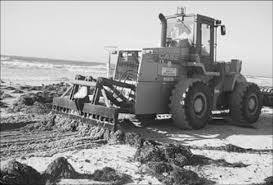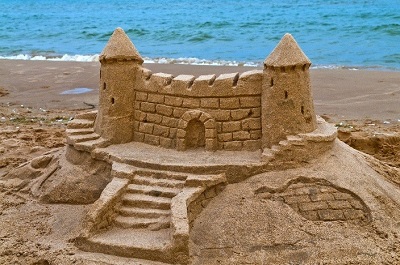Environmentally Prudent?
A vibrant ecosystem thrives along the coastline of the Great Lakes, below and above the waterline. More of this ecosystem is visible during times, like these, of low lake levels. Areas underwater during a high water cycle are now exposed, forming a coastal wetland. Owners of lake front property must be stewards of the wetlands and preserve and protect the coastline.
This is what I actually believe. But what I really want is a sandy beach. I want to get rid of all of the vegetation and growth along my shoreline and create my own personal Wakiki.
I own some frontage on Grand Traverse Bay. We have a beautiful, but small, sandy beach area. The rest of our waterfront looks like a jungle. Bulrushes, beach grass, and many other forms of plant life (which I am unable to identify) occupy large tracks of the beach.

Some land owners on the Great Lakes combat these growths with beach grooming. This means large tractors with rakes pulled behind. Grooming can remove trash and debris from the beach. It almost always beautifies the beach.
But grooming also damages the environment.
Here’s some of the things which might happen with beach grooming.
1. Grooming may accelerate beach erosion, and erosion of adjacent uplands. The roots of beach plants mat together beneath a layer of sand. This binds the sand and protects against erosion. These beach plants are exposed, and thus easily removable, with the lake levels at a low cycle. When the lake level rises, as it inevitably will, these underwater roots will preserve the beach and protect it from the constant, and sometimes severe, wave action.
2. Beach grasses are a component of the food chain, and grooming may reduce diversity and abundance of beach-grass associated animals – mammals and reptiles.
3. For the same reason, grooming may reduce the abundance of shorebirds – both local and migratory. This affects both ends of the food chain – the small birds which feed along the shore lines, and predatory hawks and eagles.
4. Rich plant life translates into rich food sources for fish. The wetlands also serve as breeding and spawning grounds for fish. One study found that 90% of all Great Lakes fish species are dependent upon coastal wetlands for some aspect of life.
5. Beach grass and indigenous plant life is usually replaced with more invasive, non-native plants species. The “weeds” take root in the clay beneath the eroded sand and, once in place, are difficult to remove.
6. Beach grass removal leads to higher relative number of flies. (I saw this listed as a side effect of grooming, but I do not know why, or what the relationship is between grooming and insects.)
7. Grooming leads to coarser sand. Beach vegetation prevent the loss of finer sediments to the winds, and groomed beaches tend to have a slightly coarser texture.
There are a number of sources on this which are all interesting reading. These include: the Michigan Land Institute, Surfrider Foundation (and its State of the Beach series), Clean Water Action Coalition, Borne of the Wind: An Introduction to the Ecology of Michigan’s Sand Dunes by Dennis Alpert, and Michigan State University Extension’s Protecting Wetlands along the Great Lakes Shoreline. Traverse Magazine ran an excellent article in the August 2003 issue, although I don’t think you can get all back-issues online.
Beach maintenance is a heavily regulated activity. A U.S. Army Corps of Engineers permit is required for leveling sand (if already free of vegetation) and grooming of the top four inches of sand (without disturbing plant roots). Removal of vegetation requires approval of both the Army Corps and the Michigan Department of Environmental Quality (and, I’m sure, comparable agencies in other states and provinces).
Permissible activities which do not require a permit include hand shoveling and manual raking, manual burying of debris, limited hand pulling of pants, and building sand castles. These “non-permitted” activities are listed in Be A Great Lakes Steward” brochure published by a coalition of governmental agencies and environmental organizations.

Wouldn’t it be incredible, and sad, if you needed to have a permit in order to build a sand castle? Isn’t it incredible, and sad, that the coalition felt it necessary to issue a brochure stating that it is “OK” to build a sand castle?
There is an inevitable tension between these environmental concerns and regulations, and the rights and desires of beach property owners. This is being played out in the legislatures and the courts. It is also being played out in my psyche.
I really, really, would like an attractive beach. I spent a fortune on this lot and would love to spend our short Michigan summers on a sandy beach. I certainly prefer it to lounging in the bulrushes.
But I don’t think I will rent a tractor and do any drastic grooming. I will be content to hand-pull weeds, or at least a sufficient number to create a small sandy area. After all, I don’t need to groom the entire shoreline. Enough area for several beach chairs will suffice.
I will also groom an area large enough for a sand castle, and I’ll do so without a permit.
